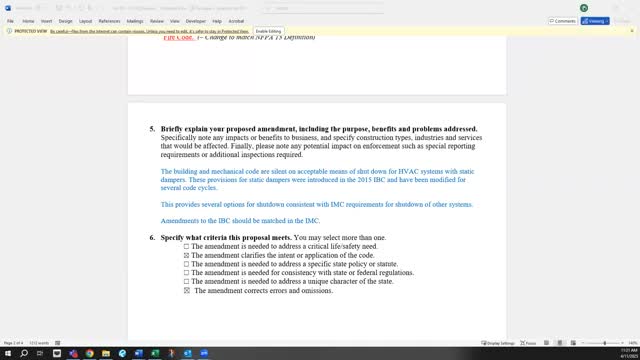BFRW committee to draft consolidated EV‑charging amendment; members push for data‑driven thresholds and flexibility on electrical sizing
April 12, 2025 | Building Code Council, Governor's Office - Boards & Commissions, Executive, Washington
This article was created by AI summarizing key points discussed. AI makes mistakes, so for full details and context, please refer to the video of the full meeting. Please report any errors so we can fix them. Report an error »

The BFRW committee on April 11 reviewed competing petitions about EV‑charging readiness, infrastructure sizing and automatic load management. After hearing proponents, utilities and industry commenters, the committee directed staff to consolidate proposals into a single BFRW draft and to post it for public comment.
Todd Bayer (committee member) presented a working draft that ties three facility categories (residential Group R, commercial, and parking/other) to staggered timelines and to an adoption forecast. The proposal discussed by staff and proponents links near‑term minimums (five‑year horizon) for EV charging and EV‑ready stalls to a longer‑term forecast (20‑year horizon) for transformer/electrical room capacity. Bayer said the approach aims to align required installation levels with regional adoption modeling (the Northwest Power and Conservation Council plan and other forecasts) rather than static percentages that may become obsolete.
Patrick Hanks, Building Industry Association of Washington, and other industry commenters urged changes to reduce near‑term construction cost impacts, recommended moving some infrastructure obligations from immediate electrical service sizing to later utility or site work, and asked for clearer alignment with the International Energy Conservation Code (IECC) definitions. Hanks also proposed that automatic load management systems (ALMS) be allowed to serve multiple categories and that exceptions for intermittent DC fast chargers be considered to incentivize commercial fast‑charging deployment.
Utilities and electrical code commenters recommended clarifying the required 40‑amp, 208/240‑volt minimum for charge points and how automatic load management can be certified and inspected. Developers warned that aggressive immediate transformer sizing requirements could delay projects when utility service or transformer upgrades are not available.
After discussion the committee voted to table the petition items and directed the standing committee to produce consolidated amendment language for public review and comment. The committee asked staff and proponents to work together to: (1) map thresholds to published adoption forecasts, (2) harmonize definitions with the IECC and the Washington administrative code, (3) refine a practical inspection path for automatic load management systems, and (4) quantify cost impacts in an economic‑impact analysis for the record.
Why it matters: EV charging requirements affect construction costs, the timing of utility upgrades and the availability of parking at multifamily and commercial developments. The committee sought a data‑driven approach to ensure minimums are defensible and practicable for jurisdictions and utilities.
What’s next: Staff will post the consolidated working draft, the committee will accept written comments and proponents will collaborate with utilities to produce revised language and cost estimates for the next BFRW meeting.
Todd Bayer (committee member) presented a working draft that ties three facility categories (residential Group R, commercial, and parking/other) to staggered timelines and to an adoption forecast. The proposal discussed by staff and proponents links near‑term minimums (five‑year horizon) for EV charging and EV‑ready stalls to a longer‑term forecast (20‑year horizon) for transformer/electrical room capacity. Bayer said the approach aims to align required installation levels with regional adoption modeling (the Northwest Power and Conservation Council plan and other forecasts) rather than static percentages that may become obsolete.
Patrick Hanks, Building Industry Association of Washington, and other industry commenters urged changes to reduce near‑term construction cost impacts, recommended moving some infrastructure obligations from immediate electrical service sizing to later utility or site work, and asked for clearer alignment with the International Energy Conservation Code (IECC) definitions. Hanks also proposed that automatic load management systems (ALMS) be allowed to serve multiple categories and that exceptions for intermittent DC fast chargers be considered to incentivize commercial fast‑charging deployment.
Utilities and electrical code commenters recommended clarifying the required 40‑amp, 208/240‑volt minimum for charge points and how automatic load management can be certified and inspected. Developers warned that aggressive immediate transformer sizing requirements could delay projects when utility service or transformer upgrades are not available.
After discussion the committee voted to table the petition items and directed the standing committee to produce consolidated amendment language for public review and comment. The committee asked staff and proponents to work together to: (1) map thresholds to published adoption forecasts, (2) harmonize definitions with the IECC and the Washington administrative code, (3) refine a practical inspection path for automatic load management systems, and (4) quantify cost impacts in an economic‑impact analysis for the record.
Why it matters: EV charging requirements affect construction costs, the timing of utility upgrades and the availability of parking at multifamily and commercial developments. The committee sought a data‑driven approach to ensure minimums are defensible and practicable for jurisdictions and utilities.
What’s next: Staff will post the consolidated working draft, the committee will accept written comments and proponents will collaborate with utilities to produce revised language and cost estimates for the next BFRW meeting.
View full meeting
This article is based on a recent meeting—watch the full video and explore the complete transcript for deeper insights into the discussion.
View full meeting
